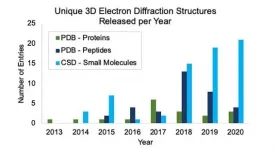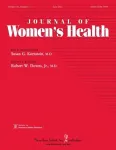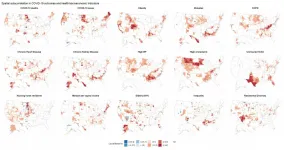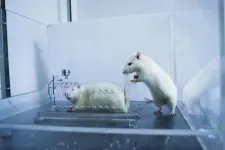Microcrystal electron diffraction supports a new drug development pipeline
2021-07-13
(Press-News.org) CAMBRIDGE July 13, 2021 - To date, solving structures of potential therapeutics using X-ray diffraction (XRD) has been an assumed, pivotal step in the drug development process. But a recent paper by a team of researchers led by NanoImaging Services shows how microcrystal electron diffraction (MicroED) is growing to obtain the structures of potential pharmaceuticals.
Three-dimensional crystal structures that show the relative positions of atoms, bonds and intramolecular interactions are needed to understand stability, reactivity, solubility and, ultimately, suitability for pharmaceutical use. Pharmaceutical researchers usually use X-ray diffraction (XRD) - with single-crystal XRD preferred - to solve crystal structures. But XRD usually requires large (100 μm or larger), well-ordered crystals and several thousand known active pharmaceutical ingredients (APIs) are available only as crystalline powders that do not readily form large crystals.
"Growing large crystals is a huge bottleneck for those interested in determining crystal structures," said author Dr. Jessica Bruhn, Scientific Group Leader - MicroED at NanoImaging Services. "MicroED can work with crystals of almost any size as it is generally fairly straightforward to break large crystals into a size suitable for MicroED."
Developments in automated data collection and data processing have led to increased interest in electron diffraction as an XRD alternative. Electron diffraction is like XRD, except that it uses a beam of electrons rather than X-rays to obtain structures. Since electrons readily interact with matter, MicroED can solve high-resolution crystal structures from sub-micron-sized crystals. It is especially exciting for small-molecule drugs, many of which readily form microcrystals, and the approach helps with the drug discovery phase when sample quantities are extremely limited. In the development phase, researchers can use it to determine structures of reaction products and by-products, which can help guide synthesis strategies and inform production decisions.
"Single-crystal X-ray diffraction is faster, cheaper and easier to access compared to electron diffraction today," said Bruhn. "However, I do expect to see electron diffraction determining more and more structures inaccessible to X-rays, such as those of transient polymorphs, helping to expand the breadth of crystal structures that can be determined."
Polymorphs are crystalline structures with the same chemical composition but different molecular packings with different lattice properties, like diamond and graphite. Most active pharmaceutical ingredients (APIs) are thought to exist in more than one polymorphic form, which can give rise to drastically different drug properties. Successful drug formulation requires selecting the optimal polymorph, and that requires easily solving structures. In addition, most drug substances being developed today exhibit poor solubility. Determining the structures of the many different forms an API can adopt (including polymorphs, co-crystals, hydrates, solvates, etc.) helps researchers better engineer optimal crystal forms with good pharmacokinetic properties.
In developing their MicroED pipeline, the researchers explored the prevalence of MicroED data available, including data stored in the Cambridge Structural Database (CSD). The CSD houses small-molecule organic and metal-organic experimental crystal structures with entries enriched and annotated by experts. About 98% of the structures in the CSD are from laboratory X-ray diffractometers, but the CSD houses a growing number of 3D electron diffraction datasets, including those solved by MicroED. Currently, there are over 100 unique datasets determined using electron diffraction in the CSD's June 2021 web and desktop offerings. In the past three years, the number of electron structures in the CSD has been increasing more rapidly, and the Cambridge Crystallographic Data Centre (CCDC) is committed to supporting scientists worldwide who are depositing and sharing their MicroED data globally.
Suzanna Ward is the Head of Database at the CCDC.
"Electron diffraction is truly one of the most exciting and rapidly evolving areas of structural science," Ward said. "Recent publications already show how it could help to speed up the development of new drugs, and we are eagerly anticipating how it might impact the volume and breadth of data we are able to share through the CSD. I think we have an interesting journey ahead of us, and it will be intriguing to see how 3D electron diffraction will be utilized in both industry and academia in the coming years."
INFORMATION:
Journal Citation
Bruhn, J. et al. Front. Mol. Biosci., 2021 8, 354.
[Attachments] See images for this press release:

ELSE PRESS RELEASES FROM THIS DATE:
2021-07-13
New Rochelle, NY, July 13, 2021--Males with COVID-19 had significantly higher rates of hospitalization and of transfer to the intensive care unit (ICU) according to a new study. A higher percentage of males died of COVID-19 compared to females, as reported in the study published in the peer-reviewed Journal of Women's Health. Click here to read the article now.
Joanne Michelle Gomez, MD, Rush University Medical Center, and coauthors, studied the first 8,108 positive COVID-19 patients that presented to the Rush University System from March 1-June 21, 2020. Nineteen percent of males required hospitalization, compared to 13% of females. ...
2021-07-13
In a new study of adults from the general population who were infected with COVID-19 in 2020, more than a quarter report not having fully recovered after six to eight months. Those findings are described this week in the open-access journal PLOS ONE by Milo Puhan and colleagues at the University of Zurich, Switzerland.
While initial public health responses to the SARS-CoV-2 virus focused on reducing the acute burden of COVID-19, a growing body of evidence indicates that the infection can also result in longer-term physical and mental health consequences. These long-term consequences, currently referred to as "post-COVID-19 syndrome" or "Long Covid" are ...
2021-07-13
COVID-19 vaccination strategies in the United States are informed by individual characteristics such as age and occupation. A study published in the open access journal PLOS Medicine by Sasikiran Kandula and Jeffrey Shaman of Columbia University, New York, United States suggests that including socioeconomic indicators as prioritization criteria for vaccination may help minimize severe outcomes, particularly deaths.
Efforts to reduce COVID-19 mortality rates in the US have focused on prioritizing vaccination initially for those at a higher risk of severe outcomes. The effectiveness of population-level ...
2021-07-13
An estimated 43 percent of the variability in U.S. COVID-19 mortality is linked with county-level socioeconomic indicators and health vulnerabilities, with the strongest association seen in the proportions of people living with chronic kidney disease and living in nursing homes. The study by Columbia University Mailman School of Public Health researchers suggests that allocating vaccines based on these factors could help minimize severe outcomes, particularly deaths. Results are published in the open-access journal PLOS Medicine.
"It is well known that COVID-19 deaths are concentrated in communities with underlying ...
2021-07-13
Researchers have conducted a global study on the effectiveness of recently established protected areas in preventing forest loss
The study explores protected area performance by countries, with South Africa, Cambodia, Latvia, Guatemala, Uruguay, Brazil and New Zealand leading the way in the effectiveness of their protected areas
The research team estimated that overall, protected areas established between 2000-2012 prevented 86,062 square kilometers of forest loss
If all countries had protected areas that were as effective as their top-performing neighbor, then an additional 33,020 square kilometers of forests would have been saved
Machine learning found that agricultural ...
2021-07-13
The University of Alberta-led research followed more than 400 infants from the CHILD Cohort Study (CHILD) at its Edmonton site. Boys with a gut bacterial composition that was high in the bacteria Bacteroidetes at one year of age were found to have more advanced cognition and language skills one year later. The finding was specific to male children.
"It's well known that female children score higher (at early ages), especially in cognition and language," said Anita Kozyrskyj, a professor of pediatrics at the U of A and principal investigator of the SyMBIOTA (Synergy in Microbiota) laboratory. "But when it comes to gut microbial ...
2021-07-13
Children exposed to elevated levels of air pollution may be more likely to have poor inhibitory control during late childhood and poor academic skills in early adolescence, including spelling, reading comprehension, and math skills. Difficulty with inhibition in late childhood was found to be a precursor to later air pollution-related academic problems. Interventions that target inhibitory control might improve outcomes.
Results of the study by researchers at the Columbia Center for Children's Environmental Health (CCCEH) at Columbia University Mailman School of Public Health and Columbia University Irving Medical Center are published in the journal Environmental ...
2021-07-13
Compared with heterosexual smokers, menthol cigarette smoking is higher among lesbian, gay and bisexual cigarette smokers, according to a Rutgers-led study, especially among bisexual and lesbian/gay female cigarette smokers.
The study, published in the journal Nicotine & Tobacco Research, examined national data from 2015 to 2019 of individuals ages 18 years and older by sex and sexual identity and found that among smokers, 54 and 50 percent of bisexual and lesbian/gay females smokers preferred menthol cigarettes, respectively, compared with 39 percent of smokers overall.
This study comes in the wake of plans by the U.S. Food and Drug Administration to ban menthol cigarettes; a move that researchers say is ...
2021-07-13
Information-rich optical imaging can provide multidimensional information to enable observation and analysis of a detected target, contributing insights into mysterious and unknown worlds. With its ability to capture dynamic scenes on picosecond—and even femtosecond—timescales, ultrafast multidimensional optical imaging has important applications in the detection of the ultrafast phenomena in physics, chemistry, and biology.
While pump-probe-based ultrafast imaging can acquire high-resolution multidimensional information, it cannot adequately capture unstable or irreversible transient scenes. Fortunately, compressed ultrafast photography (CUP), based ...
2021-07-13
A decade after scientists discovered that lab rats will rescue a fellow rat in distress, but not a rat they consider an outsider, new research from the University of California, Berkeley, pinpoints the brain regions that drive rats to prioritize their nearest and dearest in times of crisis. It also suggests humans may share the same neural bias.
The findings, published today, Tuesday, July 13, in the journal eLife, suggest that altruism, whether in rodents or humans, is motivated by social bonding and familiarity rather than sympathy or guilt.
"We have found that the group identity ...
LAST 30 PRESS RELEASES:
[Press-News.org] Microcrystal electron diffraction supports a new drug development pipeline






